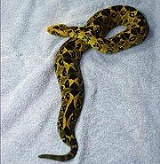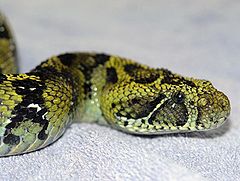
Bitis parviocula
Encyclopedia
- Common names: Ethiopian mountain adder.
Bitis parviocula is a venomous
Venomous snake
"Poisonous snake" redirects here. For true poisonous snakes, see Rhabdophis.Venomous snakes are snakes which have venom glands and specialized teeth for the injection of venom...
viper
Viperinae
The Viperinae, or viperines, are a subfamily of venomous vipers found in Europe, Asia and Africa. They are distinguished by their lack of the heat-sensing pit organs that characterize their sister group, the Crotalinae. Currently, 12 genera and 66 species are recognized...
species
Species
In biology, a species is one of the basic units of biological classification and a taxonomic rank. A species is often defined as a group of organisms capable of interbreeding and producing fertile offspring. While in many cases this definition is adequate, more precise or differing measures are...
found only in south-west Ethiopia
Ethiopia
Ethiopia , officially known as the Federal Democratic Republic of Ethiopia, is a country located in the Horn of Africa. It is the second-most populous nation in Africa, with over 82 million inhabitants, and the tenth-largest by area, occupying 1,100,000 km2...
. It is large with a broad head and spectacular geometric markings. In 1995, the species was known from only three specimens, but additional information has surfaced since then. Little is known about its natural history or its venom. No subspecies are currently recognized.
Description
Of the first three specimens, the maximum recorded was 75.2 centimetres (29.6 in) in length, but it is now known to reach at least 130 centimetres (51.2 in). The head is long, flat, triangular and covered with small, strongly keeled scalesKeeled scales
Keeled scales refer to reptile scales that, rather than being smooth, have a ridge down the center that may or may not extend to the tip of the scale, making them rough to the touch...
. Both the eyes and the nostrils are large, with the latter set well forward. The head is distinct from the thin neck. The body is cylindrical with a slight vertebral ridge, while the tail short. The dorsal scales
Dorsal scales
In snakes, the dorsal scales are the longitudinal series of plates that encircle the body, but do not include the ventral scales.When counting dorsal scales, numbers are often given for three points along the body, for example 19:21:17...
are keeled and number 37-39 at midbody.

Geographic range
Known from only five localities in the highlands to south-west EthiopiaEthiopia
Ethiopia , officially known as the Federal Democratic Republic of Ethiopia, is a country located in the Horn of Africa. It is the second-most populous nation in Africa, with over 82 million inhabitants, and the tenth-largest by area, occupying 1,100,000 km2...
, at altitudes of 1700–2800 m (5,577.4–9,186.4 ft). The type locality is given as "Doki River bridge (8°20′N 35°56′E), bei Yambo (=Yembo), an der Straße von Metu nach Bedelle, Provinz Illubabor, SW-Äthiopien" [Ethiopia].
Habitat
Of the three specimens that were known in 1995, two were found in forested areas west of the Rift ValleyGreat Rift Valley
The Great Rift Valley is a name given in the late 19th century by British explorer John Walter Gregory to the continuous geographic trench, approximately in length, that runs from northern Syria in Southwest Asia to central Mozambique in South East Africa...
and one was found in grassland to the east. Of the two western specimens, one was caught in a forest clearing in an old coffee plantation, while the other was found in a forest town, hiding in grass of the grounds of a brewery. The eastern specimen was found in high grassland near a rocky stream.
Behavior
Mostly unknown. Assumed to be terrestrial and nocturnal. In 1995, the only living specimen known was less irritable than the typical puff adder (B. arietansBitis arietans
Bitis arietans is a venomous viper species found in savannah and grasslands from Morocco and western Arabia throughout Africa except for the Sahara and rain forest regions. It is responsible for causing the most fatalities in Africa owing to various factors, such as its wide distribution and...
) and was not inclined to strike. However, it hissed when teased and struggled "furiously" when restrained, suggesting that its temperament may be similar to that of the Gaboon viper (B. gabonica
Bitis gabonica
Bitis gabonica is a venomous viper species found in the rainforests and savannas of Sub-Saharan Africa. This is not only the largest member of the genus Bitis, but also the world's heaviest viperid and it has the longest fangs ,and the highest venom yield of any venomous snake...
).
Venom
The toxicity and composition of the venom is unknown. The first US envenomation of a person was in March 2009.Dr. Earl Turner, a noted herpetologist from Ingram, Texas was bitten on the finger. He is the only person in the world known to have survived a bite from this species. It is assumed that it is the cause of at least some of the bites reported in the densely populated regions where it occurs. The local people consider it very dangerous.External links
- Bitis parviocula image at Blue Chameleon Ventures. Accessed 6 June 2006.. Accessed 25 January 2009.. Accessed 25 January 2009.. Accessed 25 January 2009.

